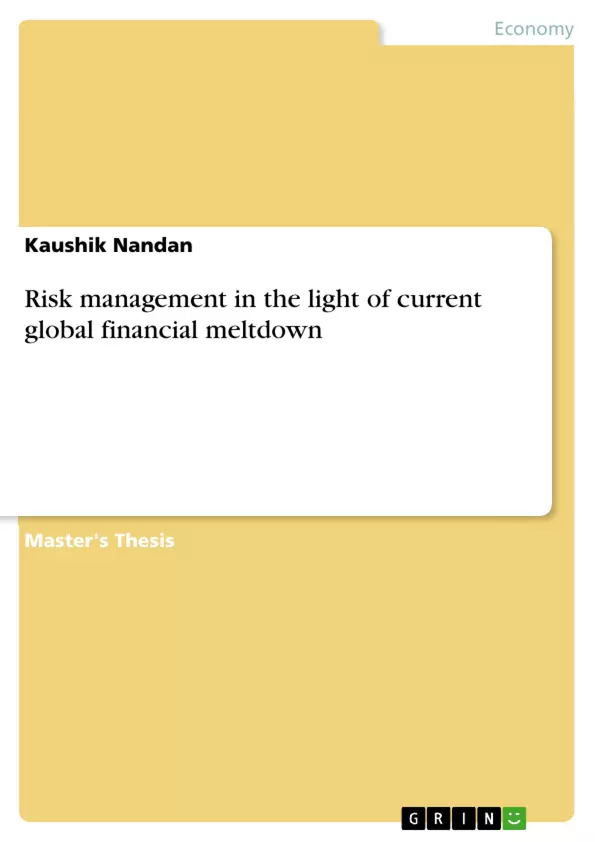The study illustrates the poor risk management by financial institutions which have resulted in the global financial meltdown. The reality of practical risk management is much complex involving issues from regulations to innovations. There are a number of issues which are interconnected and financial innovations have tied everything together in such a way that it has created a huge systemic risk for the whole financial system. The evaluation of the failed risk management which was practiced in reality is the focus of this dissertation. The dissertation begins with the established risk management theories and different types of risks that can be identified. The models that are critiqued in the study are widely used by present financial institutions. The issue of subprime crisis which eventually led to the global financial meltdown is something not found directly in risk management theories. Further insight is provided with two case studies. Solution to the issue is deliberately not suggested as it would be another temporary solution before the next crisis. It is risk managers and top management who has to take rational decisions and carefully analyze their investment decisions.
Inhaltsverzeichnis (Table of Contents)
- Chapter 1 Introduction
- Methodology
- Chapter 2 Established Theories
- 2.1 Risk & risk management
- 2.2 Different forms of risks
- 2.2(i) Market Risk
- 2.2(ii) Credit Risk
- 2.2(iii) Liquidity Risk
- 2.2(iv) Interest Rate Risk
- 2.2(v) Off-Balance Sheet Risks
- 2.2(vi) Foreign Exchange Risks
- 2.2(vii) Systemic risk
- Chapter 3 Models
- 3.1 Value at risk (VaR)
- 3.1(i) Limitations of VaR
- 3.2 KMV Portfolio Model
- 3.2(i) Limitations of KMV portfolio model
- 3.3 Conclusion
- Chapter 4 The Crisis
- 4.1 Overview of the recent crisis
- 4.2 Different toxic risk management instruments of the new era
- 4.2(i) Hedge Funds
- 4.2(ii) Collateralized Debt Obligation
- 4.2(iii) Structured Investment Vehicle
- 4.2(iv) Credit Default Swaps
- 4.3 Seemed to be a Brilliant Strategy
- Chapter 5 The Reality Of Practical Risk Management
- 5.1 Inadequate Risk Evaluation
- 5.2 Serious Issues
- 5.2(i) Credit Rating Agencies
- 5.2(ii) Hedge Funds
- 5.2(iii) Mortgage Broking
- 5.2(iv) Liquidity
- 5.2(v) Capital Adequacy
- 5.2(vi) Transparency
- 5.3 Creating Problems Worldwide
- 5.4 MainCulprits
- Chapter 6 Lehman Brothers
- 6.1 Background
- 6.2 Post Mortem
- Chapter 7 AIG
- 7.1 Background
- 7.2 Post Mortem
Zielsetzung und Themenschwerpunkte (Objectives and Key Themes)
This dissertation aims to illustrate the poor risk management practices by financial institutions that contributed to the global financial meltdown. It delves into the complex realities of practical risk management, encompassing factors like regulations, innovations, and the interconnectedness of various issues.
- The impact of financial innovations on systemic risk within the financial system
- The role of established risk management theories in the context of the subprime crisis
- The limitations of widely used risk management models, such as VaR and KMV, in mitigating the crisis
- The significance of inadequate risk evaluation and assessment by financial institutions
- The impact of various contributing factors, including credit rating agencies, hedge funds, and liquidity issues, on the meltdown
Zusammenfassung der Kapitel (Chapter Summaries)
Chapter 1 introduces the concept of risk management in relation to profit generation and the emergence of the subprime crisis as a catalyst for the global financial turmoil. Chapter 2 outlines established risk management theories and discusses various types of risks faced by financial institutions. Chapter 3 examines the limitations of two commonly used risk management models, Value at Risk (VaR) and the KMV portfolio model.
Chapter 4 provides an overview of the subprime crisis and its causes, highlighting the role of financial innovations like collateralized debt obligations, structured investment vehicles, and credit default swaps. Chapter 5 delves into the inadequate risk evaluation practices of financial institutions, analyzing the shortcomings of credit rating agencies, hedge funds, and other critical factors that amplified the crisis.
Chapter 6 focuses on the case study of Lehman Brothers, examining its financial structure, reliance on short-term debt financing, and its failure to anticipate and mitigate the impact of the crisis. Chapter 7 investigates the case study of AIG, highlighting its exposure to credit default swaps and the weaknesses in its risk management models that contributed to its near-collapse.
Schlüsselwörter (Keywords)
Key terms and concepts explored in the dissertation include risk management, global financial meltdown, subprime crisis, financial innovations, systemic risk, Value at Risk (VaR), KMV portfolio model, credit rating agencies, hedge funds, liquidity risk, capital adequacy, transparency, Lehman Brothers, and AIG.
- Citar trabajo
- Kaushik Nandan (Autor), 2009, Risk management in the light of current global financial meltdown, Múnich, GRIN Verlag, https://www.grin.com/document/295299



